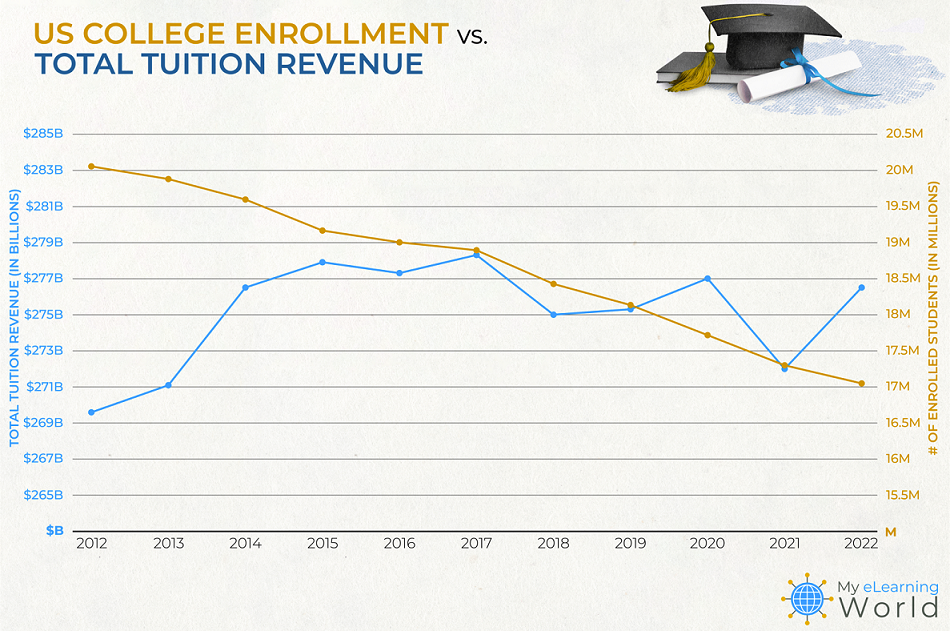 Enrollment in US colleges and universities has sharply declined over the last decade, but does that mean schools are seeing less revenue from tuition?
Enrollment in US colleges and universities has sharply declined over the last decade, but does that mean schools are seeing less revenue from tuition?
While the COVID-19 pandemic certainly accelerated the enrollment decline trend, the crisis has been going on for years.
Thanks to skyrocketing tuition costs that have drastically outpaced inflation, many young people have sought out alternatives to the traditional college experience that might be more affordable and better suited to their needs.
The rise in online education, coding boot camps, and other options has given students more choices when it comes to attaining higher education.
But here’s the thing — our analysis found that even though college enrollment has dropped by a whopping 15.3% since 2012, colleges and universities are still raking in 2.54% more in total revenue from students paying tuition.
By the Numbers

According to data from the National Student Clearinghouse Research Center (NSCRC), in fall 2012, total enrollment across all two and four-year universities totaled 20.2 million students. Fast forward 10 years and early estimates for the fall 2022 semester show that number has plummeted to 17.1 million students — a loss of 3.1 million enrolled individuals over the course of a decade.
Here’s a look at total fall semester enrollment numbers over the last decade (includes enrollment at public two-year community college, public four-year universities, and private four-year universities):
- 2012–20,195,924
- 2013–19,885,203
- 2014–19,619,773
- 2015–19,280,473
- 2016–19,010,459
- 2017–18,811,280
- 2018–18,482,391
- 2019–18,239,874
- 2020–17,778,484
- 2021–17,302,364
- 2022–17,112,038
While some might assume that losing millions of students would cause a decrease in revenue, our analysis revealed that hasn’t been the case at all.
In fact, we found that total annual revenue for US colleges from tuition and fees has increased by at least $6.9 billion over the last decade.
We calculated this number by looking at student enrollment data from NSCRC for the past 10 years across all sectors — community colleges, public universities, and private universities. We then looked at the College Board’s historical tuition data by year for each of those sectors.
By bringing together the two data sets, we were able to see exactly how the enrollment decline impacted total tuition revenue for colleges and universities.
- Community colleges–In 2012, two-year colleges had an average tuition of $3,560 for a full school year, pulling in $23.9 billion in revenue (6.7 million students). In 2022, community college tuition only rose a bit to $3,860 per year, for a total of $17.9 billion in tuition revenue (4.6 million students). It’s worth noting that two-year colleges are the only type of school to lose tuition revenue over this time period.
- Public universities–In 2012, four-year public universities had an average in-state tuition of $9,780 for a full school year, pulling in at least $76 billion in revenue (likely higher as out-of-state tuition rates are higher, but data on enrollment numbers for in-state vs out-of-state was unavailable for the 7.8 million total students). In 2022, public university tuition at four-year schools rose to $10,940 per year, for a total of at least $83.6 billion in tuition revenue (7.6 million students).
- Private universities–In 2012, private universities had an average tuition of $32,790 for a full school year, pulling in $169.8 billion in revenue (5.2 million students). In 2022, tuition for four-year private universities increased to $39,400 per year, for a total of $175 billion in tuition revenue (4.4. million students).
Will Colleges Try to Reverse the Enrollment Decline Trend?
More students than ever are opting to pursue other options outside of the traditional college experience to further their education, in large part due to out-of-control tuition costs.
As we recently reported, the cost of going to college has risen at nearly 5 times the rate of inflation over the last 50 years, giving many students major pause about paying exorbitant tuition fees.
Typically, when an organization has priced out a significant segment of their target audience, they will adjust prices to try and recapture these lost customers, but since most schools are bringing in more revenue than ever, even with fewer paying students, do colleges even have the incentive to make prices more affordable?
That remains to be seen, but in a time when the cost of higher education is at record highs, one can’t help but wonder if colleges will ever take some action to adjust tuition prices and try to reverse this enrollment decline trend.
In the meantime, many young adults are even opting to get career training on online learning sites like Coursera, Udemy, and Skillshare at a fraction of the cost of college (but without the prestigious degree).
Perhaps the schools will eventually figure out the right balance between tuition costs and enrollment numbers, but until then, the enrollment decline trend will likely continue.
- Elevating Your Virtual Presence: Why EMEET’s SmartCam S800 Stands Out in Modern Communication - 06/04/2025
- US Teachers Will Spend $3.35 Billion of Their Own Money on Classroom Expenses in 2025-25 School Year - 06/04/2025
- Report: Leveraging AI Tools Could Help US Teachers Avoid $43.4 Billion of Unpaid Overtime Work - 06/04/2025

